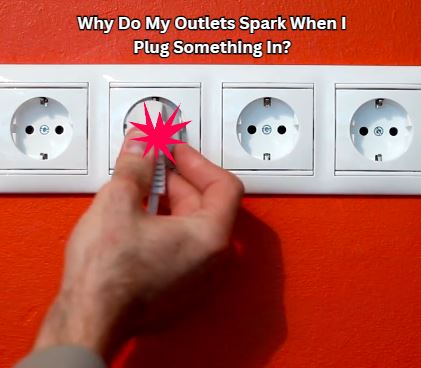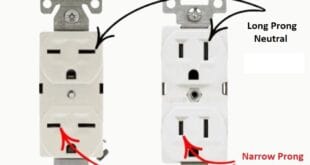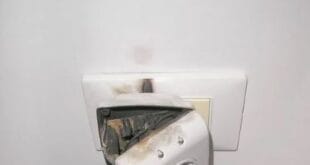Why Do My Outlets Spark When I Plug Something In?
It happens in a flash. You plug in your phone charger or your hair dryer, and suddenly, a little spark appears from the outlet. It might make you pause and wonder: Is this normal, or is something wrong? Here’s everything you need to know about sparking outlets and whether you should be concerned.
Understanding the Spark: Normal or Dangerous?
Before we get into the details, it’s important to understand that not every spark is dangerous. In many cases, a small spark when plugging in a device is completely normal. However, if you notice sparks frequently or they’re accompanied by other issues, it’s a sign that something could be wrong with your electrical system.
Let’s start by looking at what causes those sparks and why they happen in the first place.

What Causes Sparking Outlets?
When you plug a device into an outlet, you’re completing an electrical circuit. The metal prongs of the plug make contact with the metal inside the outlet, allowing electricity to flow from the power source into your device.
Here’s where the spark comes in. As the prongs make contact, there’s a brief moment when electricity jumps from the outlet to the plug before the connection is fully established. This can cause a small spark, known as an electrical arc. It’s similar to how static electricity causes a tiny spark when you touch a doorknob after walking across a carpet.
In most cases, this quick spark is harmless. It’s simply the electricity flowing as the connection is made. However, some situations can cause larger, more frequent sparks that indicate a problem.
When Are Sparking Outlets Normal?
A small, quick spark when plugging in a device is generally normal and nothing to worry about. This is especially common when you’re plugging in something that draws a lot of power, like a vacuum cleaner or a hairdryer. These devices require a surge of electricity when they first start, which can cause a tiny spark at the outlet.
Other common scenarios where sparking is normal include:
High-powered devices: Larger appliances that draw significant power may cause brief sparks.
Quick plug insertion: When you plug in a device quickly, it can create a spark as the prongs make contact with the outlet.
Worn-out outlets: Over time, the contacts inside an outlet can wear out, which may lead to small sparks when plugging in a device.
When Should You Be Concerned About Sparking Outlets?
While occasional sparks are normal, there are situations where sparking outlets could indicate a problem. If you notice any of the following issues, it’s time to call an electrician:
Frequent or large sparks: If your outlets spark every time you plug something in, or if the sparks are large and noticeable, there could be an issue with the wiring or the outlet itself.
Burning smell or heat: If you smell burning or notice that the outlet feels hot to the touch, there’s a chance that the wiring behind the outlet is damaged or faulty. This is a serious fire hazard and should be addressed immediately.
Discolored or blackened outlets: Sparks that leave scorch marks or cause discoloration on the outlet are a sign of electrical arcing, which can lead to fires if not fixed.
Flickering lights or device malfunctions: If plugging something in causes nearby lights to flicker or the device doesn’t work properly, it could indicate a wiring issue in the circuit.
What Are the Dangers of Electrical Arcing?
When we talk about sparks, we’re often referring to electrical arcing. This happens when electricity jumps between two points, creating heat. Over time, electrical arcing can damage outlets, wires, and electrical devices. In severe cases, it can cause fires.
Here are some common dangers associated with electrical arcing:
Fire hazards: The heat generated by arcing can ignite nearby materials, leading to electrical fires.
Damage to devices: Electrical arcing can damage the internal components of devices, causing them to malfunction or fail.
Burns and electric shock: In rare cases, electrical arcing can cause burns or electric shock if you touch the outlet while it’s sparking.
To prevent these dangers, it’s important to keep an eye out for signs of trouble, such as frequent sparks, burning smells, or outlets that are warm to the touch.
How to Prevent Sparks and Stay Safe
If you’re concerned about sparking outlets, here are some steps you can take to keep your home safe:
Replace old or worn-out outlets: If you notice frequent sparks or if the outlet feels loose when plugging in a device, it might be time to replace the outlet. Old outlets with worn contacts are more likely to spark.
Use quality plugs and outlets: Avoid using cheap or damaged plugs, as these can cause poor connections and increase the risk of sparks.
Don’t overload outlets: Plugging too many devices into a single outlet can cause it to overheat and spark. Use surge protectors and avoid overloading circuits.
Call a licensed electrician: If you notice frequent or large sparks, burning smells, or discoloration, don’t hesitate to call a professional. A licensed electrician can diagnose the issue and make necessary repairs to prevent fires.
When to Call an Electrician
It’s important to know when to seek professional help. If you’re unsure whether the sparks you’re seeing are normal, it’s always better to be safe than sorry. Here are the main situations where you should call an electrician:
- Large, frequent sparks
- Scorched or discolored outlets
- Burning smells or warm outlets
- Flickering lights or device issues when plugging in
An electrician can inspect your outlets, identify any underlying issues, and ensure your home’s electrical system is safe.
 Electrical Engineering World Wiring a Brighter Tomorrow!
Electrical Engineering World Wiring a Brighter Tomorrow!


